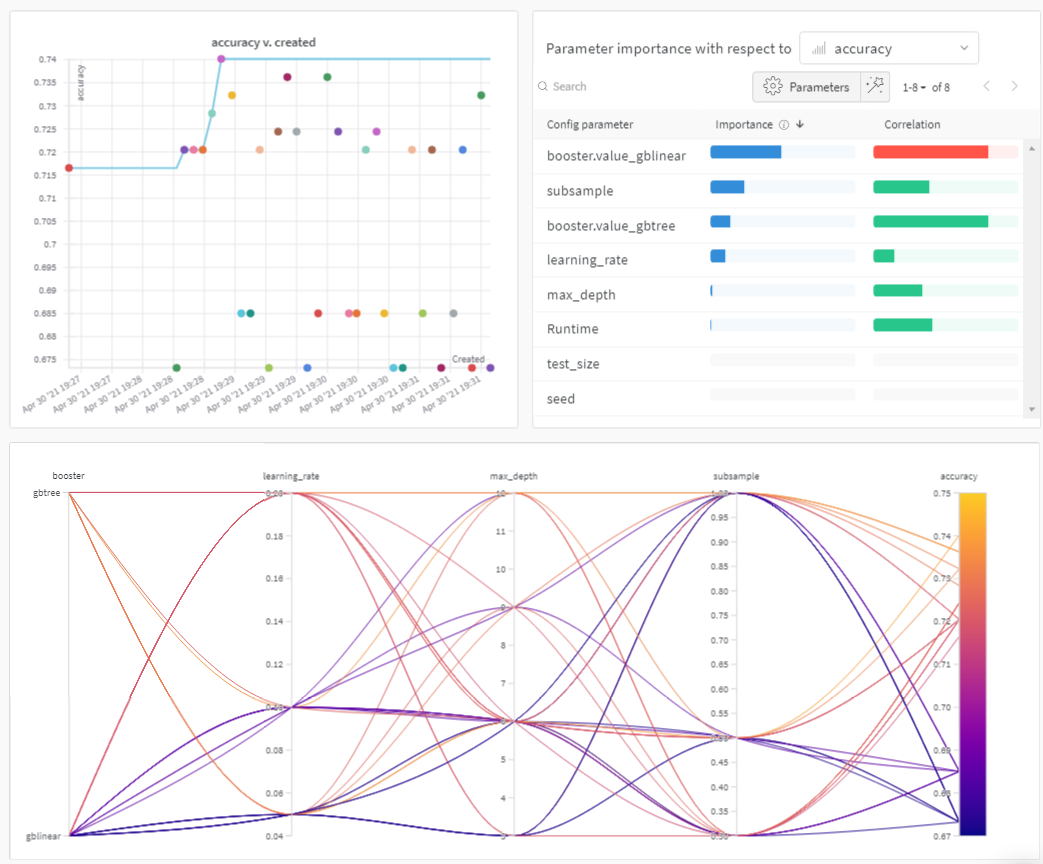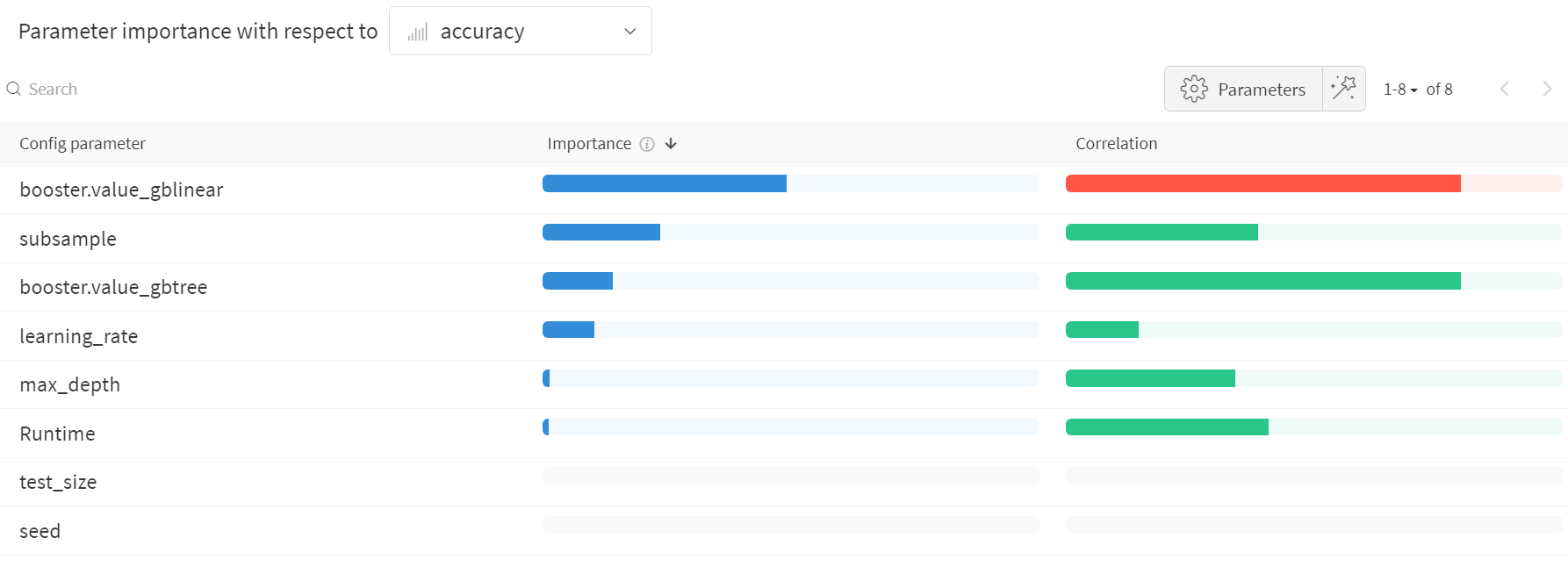XGBoost Sweeps
Try in a Colab Notebook here →
Use Weights & Biases for machine learning experiment tracking, dataset versioning, and project collaboration.
Squeezing the best performance out of tree-based models requires
selecting the right hyperparameters.
How many early_stopping_rounds? What should the max_depth of a tree be?
Searching through high dimensional hyperparameter spaces to find the most performant model can get unwieldy very fast. Hyperparameter sweeps provide an organized and efficient way to conduct a battle royale of models and crown a winner. They enable this by automatically searching through combinations of hyperparameter values to find the most optimal values.
In this tutorial we'll see how you can run sophisticated hyperparameter sweeps on XGBoost models in 3 easy steps using Weights and Biases.
For a teaser, check out the plots below:

Sweeps: An Overview
Running a hyperparameter sweep with Weights & Biases is very easy. There are just 3 simple steps:
Define the sweep: we do this by creating a dictionary-like object that specifies the sweep: which parameters to search through, which search strategy to use, which metric to optimize.
Initialize the sweep: with one line of code we initialize the sweep and pass in the dictionary of sweep configurations:
sweep_id = wandb.sweep(sweep_config)Run the sweep agent: also accomplished with one line of code, we call w
andb.agent()and pass thesweep_idalong with a function that defines your model architecture and trains it:wandb.agent(sweep_id, function=train)
And voila! That's all there is to running a hyperparameter sweep!
In the notebook below, we'll walk through these 3 steps in more detail.
We highly encourage you to fork this notebook, tweak the parameters, or try the model with your own dataset!
Resources
!pip install wandb -qU
import wandb
wandb.login()
1. Define the Sweep
Weights & Biases sweeps give you powerful levers to configure your sweeps exactly how you want them, with just a few lines of code. The sweeps config can be defined as a dictionary or a YAML file.
Let's walk through some of them together:
- Metric – This is the metric the sweeps are attempting to optimize. Metrics can take a
name(this metric should be logged by your training script) and agoal(maximizeorminimize). - Search Strategy – Specified using the
"method"key. We support several different search strategies with sweeps. - Grid Search – Iterates over every combination of hyperparameter values.
- Random Search – Iterates over randomly chosen combinations of hyperparameter values.
- Bayesian Search – Creates a probabilistic model that maps hyperparameters to probability of a metric score, and chooses parameters with high probability of improving the metric. The objective of Bayesian optimization is to spend more time in picking the hyperparameter values, but in doing so trying out fewer hyperparameter values.
- Parameters – A dictionary containing the hyperparameter names, and discrete values, a range, or distributions from which to pull their values on each iteration.
You can find a list of all configuration options here.
sweep_config = {
"method": "random", # try grid or random
"metric": {
"name": "accuracy",
"goal": "maximize"
},
"parameters": {
"booster": {
"values": ["gbtree","gblinear"]
},
"max_depth": {
"values": [3, 6, 9, 12]
},
"learning_rate": {
"values": [0.1, 0.05, 0.2]
},
"subsample": {
"values": [1, 0.5, 0.3]
}
}
}
2. Initialize the Sweep
Calling wandb.sweep starts a Sweep Controller --
a centralized process that provides settings of the parameters to any who query it
and expects them to return performance on metrics via wandb logging.
sweep_id = wandb.sweep(sweep_config, project="XGBoost-sweeps")
Define your training process
Before we can run the sweep, we need to define a function that creates and trains the model -- the function that takes in hyperparameter values and spits out metrics.
We'll also need wandb to be integrated into our script.
There's three main components:
wandb.init()– Initialize a new W&B run. Each run is single execution of the training script.wandb.config– Save all your hyperparameters in a config object. This lets you use our app to sort and compare your runs by hyperparameter values.wandb.log()– Logs metrics and custom objects – these can be images, videos, audio files, HTML, plots, point clouds etc.
We also need to download the data:
!wget https://raw.githubusercontent.com/jbrownlee/Datasets/master/pima-indians-diabetes.data.csv
# XGBoost model for Pima Indians dataset
from numpy import loadtxt
from xgboost import XGBClassifier
from sklearn.model_selection import train_test_split
from sklearn.metrics import accuracy_score
# load data
def train():
config_defaults = {
"booster": "gbtree",
"max_depth": 3,
"learning_rate": 0.1,
"subsample": 1,
"seed": 117,
"test_size": 0.33,
}
wandb.init(config=config_defaults) # defaults are over-ridden during the sweep
config = wandb.config
# load data and split into predictors and targets
dataset = loadtxt("pima-indians-diabetes.data.csv", delimiter=",")
X, Y = dataset[:, :8], dataset[:, 8]
# split data into train and test sets
X_train, X_test, y_train, y_test = train_test_split(X, Y,
test_size=config.test_size,
random_state=config.seed)
# fit model on train
model = XGBClassifier(booster=config.booster, max_depth=config.max_depth,
learning_rate=config.learning_rate, subsample=config.subsample)
model.fit(X_train, y_train)
# make predictions on test
y_pred = model.predict(X_test)
predictions = [round(value) for value in y_pred]
# evaluate predictions
accuracy = accuracy_score(y_test, predictions)
print(f"Accuracy: {accuracy:.0%}")
wandb.log({"accuracy": accuracy})
3. Run the Sweep with an agent
Now, we call wandb.agent to start up our sweep.
You can call wandb.agent on any machine where you're logged into W&B that has
- the
sweep_id, - the dataset and
trainfunction
and that machine will join the sweep!
Note: a
randomsweep will by defauly run forever, trying new parameter combinations until the cows come home -- or until you turn the sweep off from the app UI. You can prevent this by providing the totalcountof runs you'd like theagentto complete.
wandb.agent(sweep_id, train, count=25)
Visualize your results
Now that your sweep is finished, it's time to look at the results.
Weights & Biases will generate a number of useful plots for you automatically.
Parallel coordinates plot
This plot maps hyperparameter values to model metrics. It’s useful for honing in on combinations of hyperparameters that led to the best model performance.
This plot seems to indicate that using a tree as our learner slightly, but not mind-blowingly, outperforms using a simple linear model as our learner.

Hyperparameter importance plot
The hyperparameter importance plot shows which hyperparameter values had the biggest impact on your metrics.
We report both the correlation (treating it as a linear predictor) and the feature importance (after training a random forest on your results) so you can see which parameters had the biggest effect and whether that effect was positive or negative.
Reading this chart, we see quantitative confirmation
of the trend we noticed in the parallel coordinates chart above:
the largest impact on validation accuracy came from the choice of
learner, and the gblinear learners were generally worse than gbtree learners.

These visualizations can help you save both time and resources running expensive hyperparameter optimizations by honing in on the parameters (and value ranges) that are the most important, and thereby worthy of further exploration.